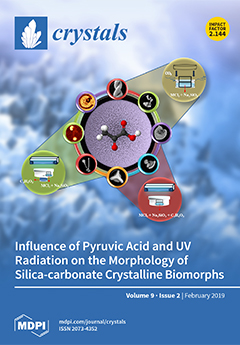We report the preparation of a series of new 4′-substituted 2,2′:6′,2″-terpyridines: 4′-(3,5-dimethylphenyl)-2,2′:6′,2″-terpyridine (
2), 4′-(3-fluoro-5-methylphenyl)-2,2′:6′,2″-terpyridine (
3), 4′-(3,5-difluorophenyl)-2,2′:6′,2″-terpyridine (
4), and 4′-(3,5- bis(trifluoromethyl)phenyl)-2,2′:6′,2″-terpyridine (
5). The compounds have been characterized by mass spectrometry, solid-state IR spectroscopy and solution NMR
[...] Read more.
We report the preparation of a series of new 4′-substituted 2,2′:6′,2″-terpyridines: 4′-(3,5-dimethylphenyl)-2,2′:6′,2″-terpyridine (
2), 4′-(3-fluoro-5-methylphenyl)-2,2′:6′,2″-terpyridine (
3), 4′-(3,5-difluorophenyl)-2,2′:6′,2″-terpyridine (
4), and 4′-(3,5- bis(trifluoromethyl)phenyl)-2,2′:6′,2″-terpyridine (
5). The compounds have been characterized by mass spectrometry, solid-state IR spectroscopy and solution NMR and absorption spectroscopies. The single-crystal X-ray diffraction structures of
3,
5 and
6·EtOH (
6 = 4′-(3,5-bis(
tert-butyl)phenyl)-2,2′:6′,2″-terpyridine) have been elucidated. The molecular structures of the compounds are unexceptional. Since
3 and
5 crystallize without lattice solvent, we are able to understand the influence of introducing substituents in the 4′-phenyl ring and compare the packing in the structures with that of the previously reported 4′-phenyl-2,2′:6′,2″-terpyridine (
1). On going from
1 to
3, face-to-face π-stacking of pairs of 3-fluoro-5-methylphenyl rings contributes to a change in packing from a herringbone assembly in
1 with no ring π-stacking to a layer-like packing. The latter arises through a combination of π-stacking of aromatic rings and N…H–C hydrogen bonding. On going from
3 to
5, N…H–C and F…H–C hydrogen-bonding is dominant, supplemented by π-stacking interactions between pairs of pyridine rings. A comparison of the packing of molecules of
6 with that in
1,
3 and
5 is difficult because of the incorporation of solvent in
6·EtOH.
Full article





